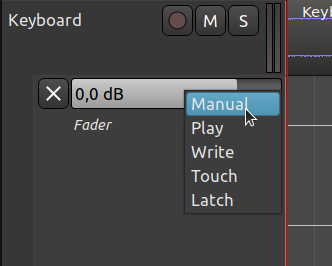Automation States
In order to understand how automation in Ardour works, it is necessary to understand the five states of automation. They are: Manual, Play, Write, Touch, and Latch.

Manual state is basically analogous to a processor's bypass switch. Whenever an automation lane is in this state, it is inactive and any level that is manually set for controlling the lane's parameter will persist during playback like normal.
In Ardour, every track and processor parameter is initially set to Manual state.
Play state tells Ardour to use the automation curve in the automation lane to control the level of the parameter controlled by the lane during playback. The control that normally sets the parameter will be unresponsive to manual input and will move automatically in accord with the lane's automation curve during playback.
Write state allows continuous, dynamic setting of a control during playback; all such settings are written to the lane the control is in. This defines the lane's automation curve in the interval being played, and overwrites any existing automation curve in the lane being manipulated. As this might be sometimes dangerous, this state is automatically changed to Touch state when playing is stopped.
Touch state is similar to Write state, except it only overwrites sections of a lane's automation curve when the control is changed in some way. This allows for changing only the parts of an automation curve that are desired to be changed, while leaving the rest unchanged.
Latch state is similar to Touch
state as it will also change automation when the control is changed in some way
during session play back.
But additionally it will overwrite the automation curve with the last
value that it was changed to until play-back is stopped.
Latch state is also useful when the user wants Touch-style behavior but is using a device incapable of sending messages to indicate the start and end of the "touch".
